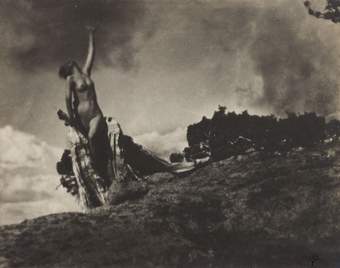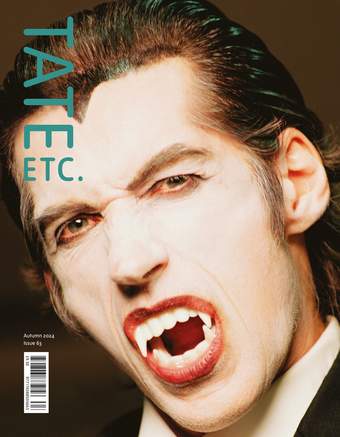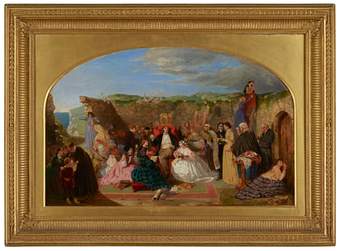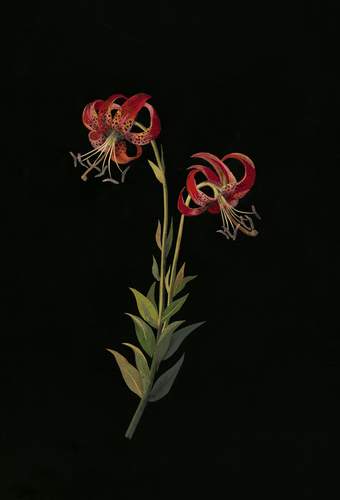
Anne Brigman
The Soul of the Blasted Pine 1906, printed c.1907–8
Courtesy Wilson Centre for Photography
The pioneering American photographer Anne Brigman (1869–1950) is best known for her series of otherworldly female nudes shot on the bare, high-altitude slopes of the Sierra Nevada. In her joyous, allusive images, we find naked, nymph-like figures bathing in clear mountain pools, or clambering over gnarled and ancient bristlecone pines. These smooth-skinned women – bold, athletic, unselfconscious – are all at once human and non-human; the landscape around them highly specific and yet oddly unreal.
To create these photographs, Brigman, her sister and friends would hike with pack mules into the mountains for weeks at a time, camping at 8000 ft (2440 m) and climbing yet higher during daytime in search of the dramatic natural staging she used as backdrop to her arcadian scenes. ‘God’s high country,’ she called this place: ‘It is primeval; it is austere; it is forbidding; it is sinister; and yet, with all it is most radiant and beautiful.’ This was a raw land above the treeline, where ragged ridgelines rimmed the sky with black, the air ‘honeysweet’ with sage.
Many of her photographs lean explicitly on pre-Christian mythology or Classical imagery – fair maidens haloed and embracing in the shadow of a great pine; sleek beauties stretch across mirrored pools – in keeping with the anti-modernist sentiments popular in Brigman’s bohemian circles at the time. But the images I respond to most strongly are those that forsake such referential artifice and blur instead the line that separates woman and nature altogether.
In The Soul of the Blasted Pine 1906 – perhaps her most famous work – a naked woman rises from the wreckage of a fallen tree, head thrown back, arm thrust to the heavens. Her face is obscured but her manner is clear: this is a posture of supplication, exultation; a creature in thrall to the forces of nature. Her torso, burnished by the sun, is felt as a continuation of the knotted, sunbleached wood below. She sought, she explained, to ‘embody’ the human form in rocks and trees, ‘to make it part of the elements not apart from them’.
We see this same instinct at work in Brigman’s Invictus c.1925 in which a radiant figure is seen entangled in sylvan limbs, and in the arched-back beauty with windswept hair amid the coiling branches of The Storm Tree 1911. These wilderness nudes present an idealised feminine beauty, as seen through the female gaze: they express a fearlessness, a freedom of expression unbridled by the inhibitions of the time – or of our own.
Brigman’s work was championed by the eminent photographer Alfred Stieglitz, who did much to cement her wider reputation, but she resented his insistence on interpreting her work through a prism of eroticism, via the writings of Sigmund Freud and Havelock Ellis. This was, she sensed, only a highbrow form of mansplaining. She did not accept what he saw in her work, in her artistic intentions.
I believe her. If there is desire in Brigman’s imagery, it is not sexual desire, or not primarily. Her models’ nakedness is not offered up in provocation but as an expression of the essential self, the intermingling of all things.
Anyone who has spent time in the wild lands Americans call ‘backcountry’ will recognise the intensity, even quasi-religious experience, that Brigman was alluding to in her work: the liberation that comes with living for extended periods in the wilderness, the dissolution of identity in the vastness of nature, a falling away of quotidian concerns.
I too have bathed naked in high alpine lakes, basked on bare granite boulders – flesh glistening, spangled with moisture – and picked my way, bare-footed, between reeds and struck out into meltwater, breath coming in gasps, shallows falling away until I found myself treading water above the abyss, suspended in a liquid of such perfect transparency I might be levitating. Far below, the shadowed forms of fallen trunks lay perfectly preserved for all time in still, icy waters.
What Brigman captures is that psychological release, the purifying clarity that comes from a life stripped back to its barest essentials. Is this sexual? Sublimated, latent... perhaps. I cannot speak for my subconscious. But I can say it does not feel sexual; only the way Brigman said it would feel – ‘emancipation from fear.’
Anne Brigman’s The Soul of the Blasted Pine is included in Now You See Us: Women Artists in Britain 1520–1920, at Tate Britain until 13 October.
Cal Flyn is a writer who lives in the Orkney Islands. Her latest book, Islands of Abandonment, is published by William Collins. She is currently working on a history of wilderness.
In partnership with Lockton. Also supported by Julia and Hans Rausing and The Christian Levett Collection with additional support from the Now You See Us Exhibition Supporters Circle, Tate Americas Foundation, Tate International Council, Tate Patrons and Tate Members.



